
 In 1853, German immigrant Heinrich Engelhard Steinweg who was known later as Henry E. Steinway, founded what would become one of the greatest success stories in American history. Heinrich’s roots in piano building began in the 1820s out of his home in Seesen, Germany. He was building pianos under the Steinweg name until he emigrated to the United States in 1850. It was in 1853 that serial number 483 was stamped into the first ever U.S. built Steinway piano as he had built 482 Steinwegs in Germany. The rest is history. Having won many awards the world over, the Steinway piano became recognized for its superior quality and was hailed for defining what was to become our concept of the modern concert instrument. They were innovative in design and helped us realize what the perfect modern concert instrument could be.
In 1853, German immigrant Heinrich Engelhard Steinweg who was known later as Henry E. Steinway, founded what would become one of the greatest success stories in American history. Heinrich’s roots in piano building began in the 1820s out of his home in Seesen, Germany. He was building pianos under the Steinweg name until he emigrated to the United States in 1850. It was in 1853 that serial number 483 was stamped into the first ever U.S. built Steinway piano as he had built 482 Steinwegs in Germany. The rest is history. Having won many awards the world over, the Steinway piano became recognized for its superior quality and was hailed for defining what was to become our concept of the modern concert instrument. They were innovative in design and helped us realize what the perfect modern concert instrument could be.
A great romance behind all this is that they have inspired generations of pianists, musicians, and composers all around the world. For over 100 years they have made their mark in music history from pioneer recordings of the 20th-century masters to live concert from the world’s leading artists. It isn’t just a name and people who know the Steinway piano are continuing its legacy through the arts. It’s not just a piano for the immortals of music, it’s a piano that can be found in many homes, churches, and institutions across the country. They are known for their longevity and are passed down from generation to generation in such a manner they can be considered a member of the family. It’s a personal piano that has moved us and inspired us, a piano we can relate to.
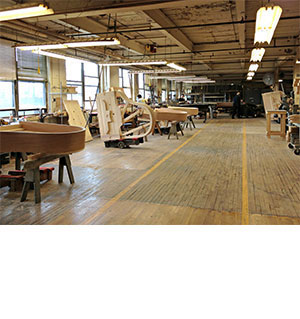 Steinway pianos are hand built in New York City as well as Hamburg, Germany. It takes a year to construct one of these masterpieces and they are made from the highest quality of natural resources that exist. There’s a lot of engineering and brilliance that goes into the development of a Steinway & Sons piano. They are well thought out in terms of design in a scientific way. Over time they have become the ideal piano for many because of their sound which is distinct and unique all on its own. It’s a powerful sound that is capable of the quietest pianissimo to the greatest fortissimo. The American sound is fat and robust to where it surrounds you in this musical heaven. The German sound is crisp and clear and it takes you to another world. Of the 12,000 parts that go into the creation of a Steinway, they all are part of what is the definitive idea of the perfect piano.
Steinway pianos are hand built in New York City as well as Hamburg, Germany. It takes a year to construct one of these masterpieces and they are made from the highest quality of natural resources that exist. There’s a lot of engineering and brilliance that goes into the development of a Steinway & Sons piano. They are well thought out in terms of design in a scientific way. Over time they have become the ideal piano for many because of their sound which is distinct and unique all on its own. It’s a powerful sound that is capable of the quietest pianissimo to the greatest fortissimo. The American sound is fat and robust to where it surrounds you in this musical heaven. The German sound is crisp and clear and it takes you to another world. Of the 12,000 parts that go into the creation of a Steinway, they all are part of what is the definitive idea of the perfect piano.
Steinway Model S Baby Grand Piano
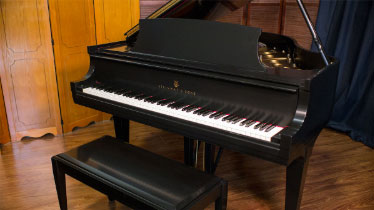
Designed by Paul Bilhuber and introduced in 1935, the model S is the most recent addition to the Steinway family. Measuring 5’ 1” and weighing only 540 lbs, the S was designed to cater to the consumer who wanted the classic statement of a grand piano in their home where space was limited. It was designed with superior quality that is typical of great American pianos. Steinways are known for their larger than life sound, so don’t let the model S’s diminutive size fool you. It’s a baby grand piano designed to be taken seriously. So if space is limited and you appreciate the elegant aesthetic of a baby grand piano as well as a world-class instrument, the Model S may be for you.

Steinway Model M Grand Piano
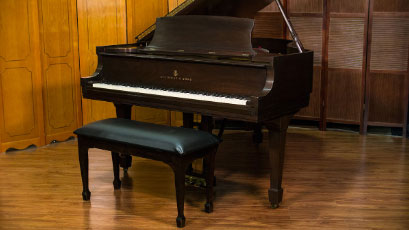
The model M is one of the most frequently seen Steinways around today. It was designed by none other than Henry Zeigler in 1911. It is produced both in New York and Hamburg but wasn’t introduced to the latter until 1926. This is the next step up in the Steinway lineup and measures in at 5’ 7” and weighs 560 lbs. It is considered a “medium grand” and allows for a bit more mass in the sound when it comes to the bass register in comparison to its little sister, the S. However, if you are confined to a smaller instrument because of space limitations or odd floor plans, have no fear because the M is here! The M is suitable in just about any intimate setting and is capable of meeting the working musician’s needs.
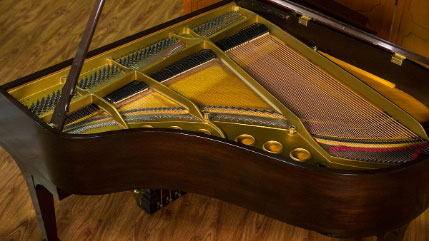
Steinway Model L Grand Piano
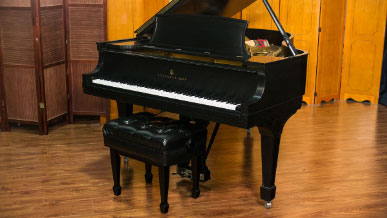
The Steinway L is a great option for people looking for a full-sized piano that will accommodate all ranges of music. Introduced in 1923 with a 26 note bass section designed by Henry Zeigler, the L was produced mainly in New York and was discontinued in 2005 when the model O was reintroduced. Measuring at 5’ 10 ½” and weighing in at 610 lbs, the L will still fit in most spaces and would be suitable in a small studio or church sanctuary. Something that is nice and convenient about Steinway grands is that the size difference between models is subtle so there are a lot of options out there for people looking to put a grand in a smaller space. This piano is sure to satisfy the needs of even the most discerning pianists.
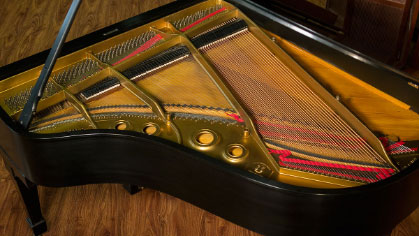
Steinway Model O Grand Piano

The Model O was developed in the latter half of 1900 and was in production until 1923 when the much sought after model L came into the picture. Earlier examples of the model O did not feature rear adjustable duplexes and this was remedied early on in its production. The model O measures 5’ 10” ¾ with a weight of 616 lbs. The most prominent difference between the L and the O is that the L has a more squared off design in the tail end. The model O is still conservative when it comes to space. For people who are looking for a piano that has the tone of a piano in the 6-foot range, the model O will do the job.
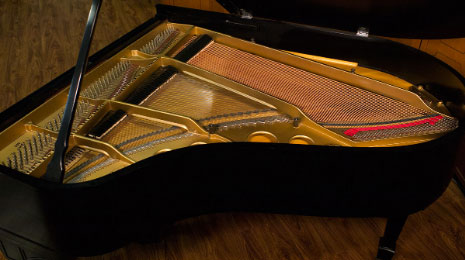
The Steinway Model A and its Variations
The Steinway A is a family all on its own with three different variations just in itself. These are known as the A-1, A-2, and A-3. All three of these wonderful scale designs are different and those differences are important. The A’s maintain a history all on their own and were a great period of experimentation in the illustrious history that is the Steinway piano.
Steinway A-1
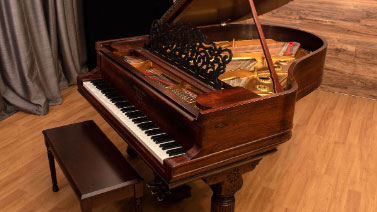
Introduced in 1878 by C.F. Theodore Steinway, the first model A had 85 notes and was 6’ feet long. At the time of its premiere, it was the smallest grand available by the company and the next in the line was the model B. The A was the first Steinway to utilize the bent rim case construction which allowed for a much broader sound using the full range of the soundboard. This also made for a much sturdier and solid cabinet construction. Most of these models may be found in art cases which were a standard of the time. Between 1892 and 1893 the 85 note version of the A was replaced with 88 notes from the design of Henry Zeigler. However, the A-1 was discontinued in 1897 with the introduction of the A-2.
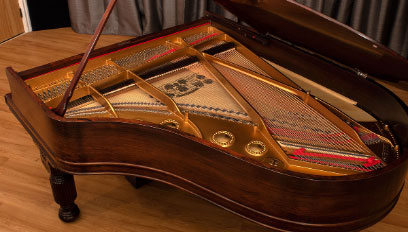
Steinway A-2
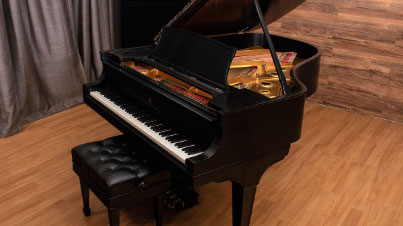
The A-2 which was also known as the “long scale” variation was brought into the pictures alongside the 88 note A-1 in 1896. The main difference between the two was that the A-2 had a more squared off tail that could accommodate a much larger soundboard. There were other slight modifications to the design. The piano became slightly longer than 6’ feet but was still listed in company catalogs as being 6’ feet in length. By 1905 the “long scale A” was replaced by the “short scale A.” This variation refined the progression from the bass register all the way to the top of the treble register to where you couldn’t hear the bass, tenor and treble section breaks. It was in full production at the New York factory until 1914 when it then moved to Hamburg. Early examples of the A-2 still featured a 19th-century cabinet design which was typical of the period. The A-2 lived on to see the birth of what we know today as the standard Steinway cabinet by Joseph Burr Tiffany. The A-2 made a return to New York production almost a century onward.
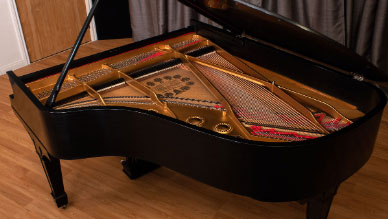
Steinway A-3
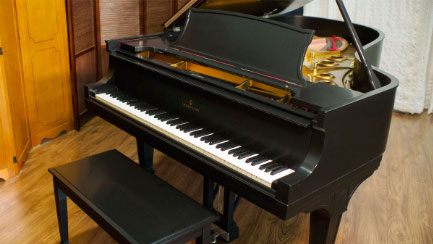
Considered to be the ultimate difference in the Steinway A family, the A-3 made the biggest leap both in sound and size compared to the A-1 and A-2. In 1913, the A-3 was brought into the Steinway & Sons Catalog sharing it with its baby sister the A-2. The A-3 measured in at 6’ 4” ½ and was not far off from what many consider to be the “perfect piano”, the model B. The A-3 was made a bit more affordable than the B and it could stand on the same level as a good B in terms of tone and performance. The A-3’s were only built in New York and never Hamburg and they were produced until 1945. Rumor suggests that Steinway ceased their production as they were too competitive with the model B. If you want something that will act like a model B without the immense footprint of 6’ 10½”, a properly restored A-3 is an option.
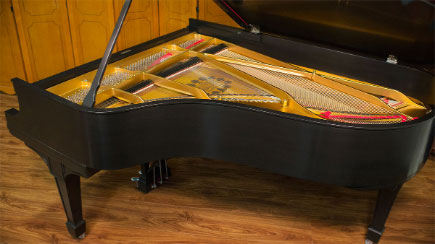
2005: The Steinway Model A returns to New York
The idea of something returning back to where it has made its mark on history is romantic like when an 83-year-old Charlie Chaplin returned to the United States after having been in Switzerland for 20 years. Beginning in 1914, the model A-2 began production at Steinway’s Hamburg factory and made a comeback to the New York family in 2005. The A-2 was being manufactured at a length of 6’ 2” for a change. Overall, the A family is known for being an extremely versatile instrument. They have made their mark on history and consist of some of Steinways greatest ideas in piano building.
Steinway Model B Semi-Concert Grand Piano
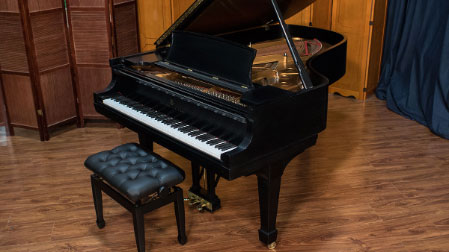
Finally, we come to one of the most popular and loved instruments in the world among pianists. Whether you are an amateur or professional pianist, chances are you have heard or played a Steinway model B. “The Perfect Piano” was brought into the picture by 1878. At a length of 6’ 11” and weighing a massive 760 lbs, this is Steinway scale design at its finest and it became renowned as offering the best balance of tone through all registers. The model B is Steinway’s most popular instrument and is built in New York as well as the Hamburg factory. They can be seen in every setting from the concert venue to the home living room. While being massive tonally, they aren’t massive structurally and will fit into any medium sized room. They have a big piano sound that can live up to the expectations of the larger model C. These are an excellent choice for any pianist at any level who wants to enjoy the experience of playing a truly world class piano.
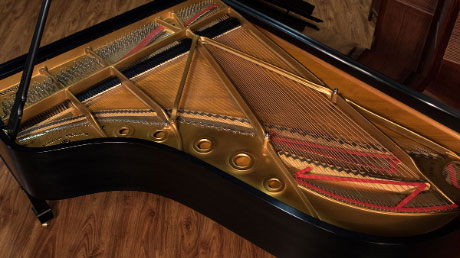
Steinway Model C Grand Piano
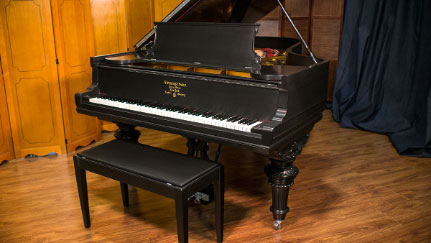
The model C came to fruition the same year as the model B, in 1878. She is considered a concert grand weighing 900 lbs with an impressive length of 7’ 5”. The C is harder to find in the United States as production ran from 1878 thru 1905 before its regular production ceased. These mammoth instruments were usually custom ordered between 1906 and 1936. However, they are in regular production at the Hamburg factory. If you don’t have the room for a model D and want something that still fits into that semi-concert or concert grand range, this won’t disappoint. The model C represents a great period in American and German piano building. With an extremely rich range of power and tone, these pianos are capable of giving any pianist a rewarding and emotionally moving experience.
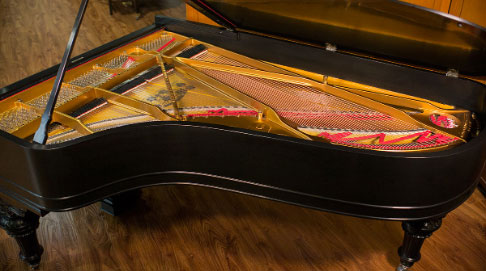
Steinway Model D Concert Grand Piano
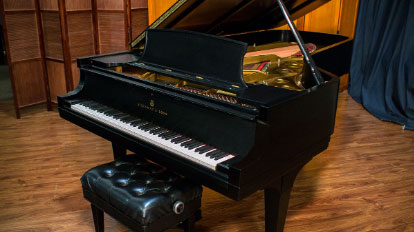
The piano that plays a tremendous role to the reasoning of why Steinway & Sons are chosen by the vast majority of the worlds finest pianists, is the model D. Commonly seen more than any other piano on the concert platform, today and over time the model D stands as a testament to the superior quality that is Steinway & Sons. The model D represents a great romantic instrument that over time, has probably played most of the entire piano repertoire. Whether it be through live performance or recordings through the hands of the greats, the model D is known by non-musicians and musicians alike. Production started in 1884 with the advent of what C. F. Theodore Steinway considered the modern concert grand. With a current length of 8’11” ¾ and weight of 990 lbs, the model D is capable of tremendous musical expression, with balance and power combined that make up a masterpiece of engineering both musically and structurally. The model D is commonly preferred by many of the world’s most esteemed universities and institutions, given their reputation and ability to let any pianist shine.
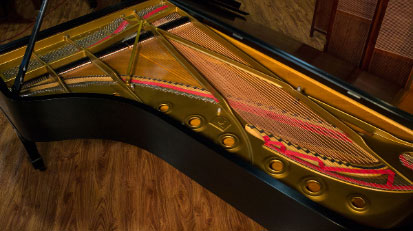
Steinway Model 1098 Upright Piano

We can’t forget uprights! The 1098 is more recent to the Steinway scene. Steinway uprights are crafted with the same level of love and attention to detail as their grands are. At a modest height of 46”½ inches and a depth of 25” inches, this piano can pack a punch and is a serious musical instrument despite its diminutive size. Weighing only 480 lbs, it’s ideal for the musician who is always moving or lives in closed in quarters. It features 125 of the patented features that make up the Steinway piano including the Diaphragmatic Soundboard, Accelerated Action, and Hexagrip pinblock. A piano that is very popular in university practice rooms and homes across the country, like any Steinway piano the 1098 is built to last and with the right care can be an heirloom as well as family treasure. On a side note, the model 4510 Sheraton is the same specification as the 1098 in a more traditional case offered in Walnut, Mahogany or Ebony.

Steinway Model K-52 Upright Piano

By 1903, the K-52 had arrived on the scene and it is still today one of the most iconic American pianos ever built. The K-52 is pretty straightforward with a height of 52” inches and a depth of 26⅜” inches. With this additional height and a weight of 600 lbs, this instrument is basically a baby grand piano in a box. Like it’s counterpart, the 1098, the K-52 will fit just about anywhere you put it while offering a substantial amount of tone that is both rich and powerful. Whether you’re learning the piano or are a studio musician, the K-52 will make you want to practice as the opportunity to play a fine instrument can be so much more fulfilling than playing a bad one.


